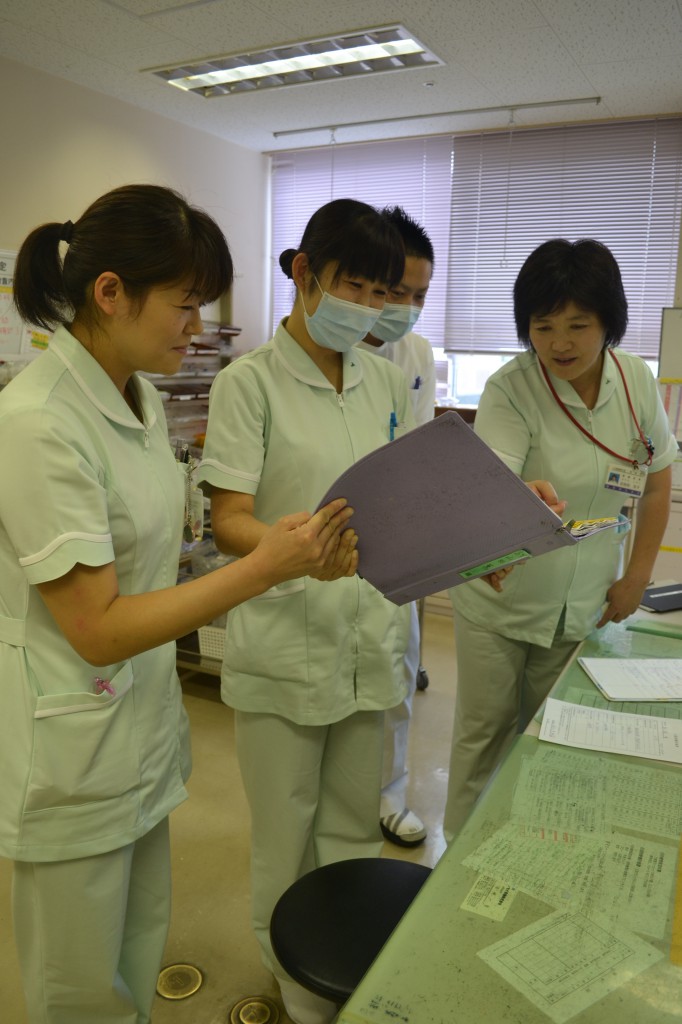Jyunichi Miura
Urgently wanted: young nurses who can work night shift. Kashima Kosei Hospital, located within 30 km of the Fukushima No.1 nuclear power plant, is suffering from chronic shortage of medical staff, especially nurses. With a number of temporary housing complexes built nearby, the hospital, run by an agricultural cooperative in Fukushima, has to accept increasing number of outpatients and emergency patients. The hospital has recruited nurses through newspaper ads and public job placement offices, but has not received many applications. Nurses, who are disaster victims themselves, are caring patients while struggling with their own psychological stress.
“We are making desperate efforts to run the hospital with a limited number of staff, because we want to support the patients and the local community,” says Tadashi Aoto, office manager of the hospital. “But we don’t know when our efforts will be rewarded. It is like being in a long tunnel with no way out.”
Lack of sufficient medical staff is a problem shared by all hospitals in the prefecture’s coastal area. “There were not many doctors and nurses in the coastal area even before the nuclear power plant accident, but not one hospital has enough staff after the accident,” says an official of the prefectural government in charge of regional medical services. “We are offering various support measures such as giving subsidies to employ doctors from outside the prefecture, but the situation is extremely serious.”
The accident not only led to shortage of medical staff but also caused a serious emotional damage to nurses.
“I am still overwhelmed with a sense of guilt when I think of the time of the accident,” Miyuki Ohashi, a 37-year-old nurse, confesses with her eyes full of tears. Ohashi, a mother of two children, left the hospital which has turned into a virtual field hospital after the disaster, and evacuated out of the prefecture. She returned to work in the hospital in April 2011, a month after the accident, but is still suffering from feelings of remorse for leaving patients in front of her.
Other nurses feel sympathetic towards Ohashi. All of them are victims of the disaster and the accident themselves. Some of them could not return home after the accident and commuted to the hospital from a temporary housing complex, and there is a nurse who lost her husband.
“All the nurses are taking care of patients while tackling with their own situations,” head nurse Tomoko Yachida, 54, says. “I still can’t figure out how to cope with their distress. I’m groping for a way out every day.”

Looking at medical records, nurses discuss ways to deal with each of the patients at a hospital in Minamisoma, Fukushima Prefecture.
Since most of the young people have left the area after the accident, most of the patients who come to the hospital are elderly people living in temporary housing units. Many of them have worries for the future, and their health deteriorates as they stay inside their houses most of the time.
Everyone in the hospital is struggling to support patients living in the disaster-hit areas, but prospects remain unclear, as radiation-contaminated water continues to flow out of the damaged Fukushima No.1 plant and the situation is unlikely to return to normal in the foreseeable future.
“We can’t move forward just by turning our backs to realities, but nothing improves if we continue to grieve over endless problems we face,” Yachida says. “We only have to do what we can do for the local community.”
Each of the staff’s endurance is narrowly supporting the medical services of the region which is on the verge of collapse.
(Sept. 12, 2013)

